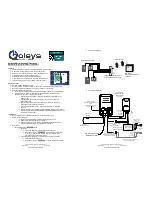
Section 6 — Effect Parameters
ASR-10 Musician’s Manual
44
Edit/Effect Parameters
ROM-47 DUCKER
The DUCKER algorithm is a compressor that automatically lowers the level of a signal (such as
music) when another signal (like an announcer voice-over) comes in. When the voice-over
leaves, the level of the original signal is restored. This algorithm is useful for voice-overs, Rap,
and DJ work. In order for this algorithm to work properly, the music (audio source to be ducked)
must be sent to BUS1 or BUS2 hard left, and the voice-over is sent to BUS1 or BUS2 hard right. In
this set up, BUS1 or BUS2 (hard right) is considered the side chain to a traditional compressor.
This algorithm employs an internal mixer that mixes left and right inputs to a mono output.
The gate function is achieved for high compression ratios. In this application a transient signal
source, such as a snare drum, can gate on and off some other music signal, to achieve an
externally controllable staccato effect.
DUCKER Signal Routing
BUS1 Left
BUS2 Left
BUS1 Right
BUS2 Right
L
Main
Output
(mono)
R
Compressor
(synthesis)
(Side
Chain In)
Output
Gain
EQ
(analysis)
EQ Trim
Ducker
Output
Mixer
OUTPUT GAIN
Range:
-48 to +48 dB
This parameter sets the amount of cut (negative values) or boost (positive values) applied to the
ducker on the output volume. We recommend a starting application of +0 dB.
OUTPUT MIX
Range:
0 to 99
This parameter mixes the output of the music signal (BUS1 or BUS2 hard left) with the output of
the ducker (voice-over) signal (BUS1 or BUS2 hard right) to a mono output. This is the Ducker
Output Mixer that is shown in the diagram.
COMP RATIO
Range:
1/1 to 40/1, INF
This parameter sets the amount of compression. The range is based on decibels (dB) above the
threshold. If this is set to 4/1 for example, it will compress changes in signals above the
threshold by one quarter. When this is set to infinity, it acts as a limiter.
THRESHOLD
Range:
-96 to +0 dB
This parameter sets the threshold level. Signals that exceed this level will be compressed, while
signals that are below will be unaffected.
ATTACK TIME
Range:
50µs to 100ms
This parameter determines the attack rate after the initial signal has been detected and before the
compression takes affect.
















































